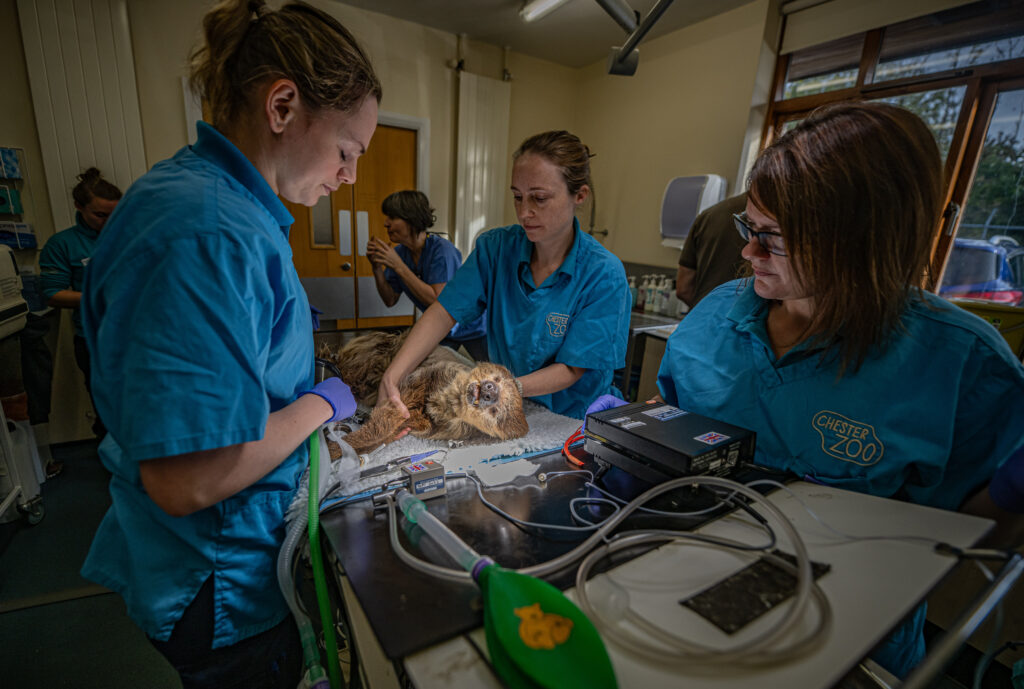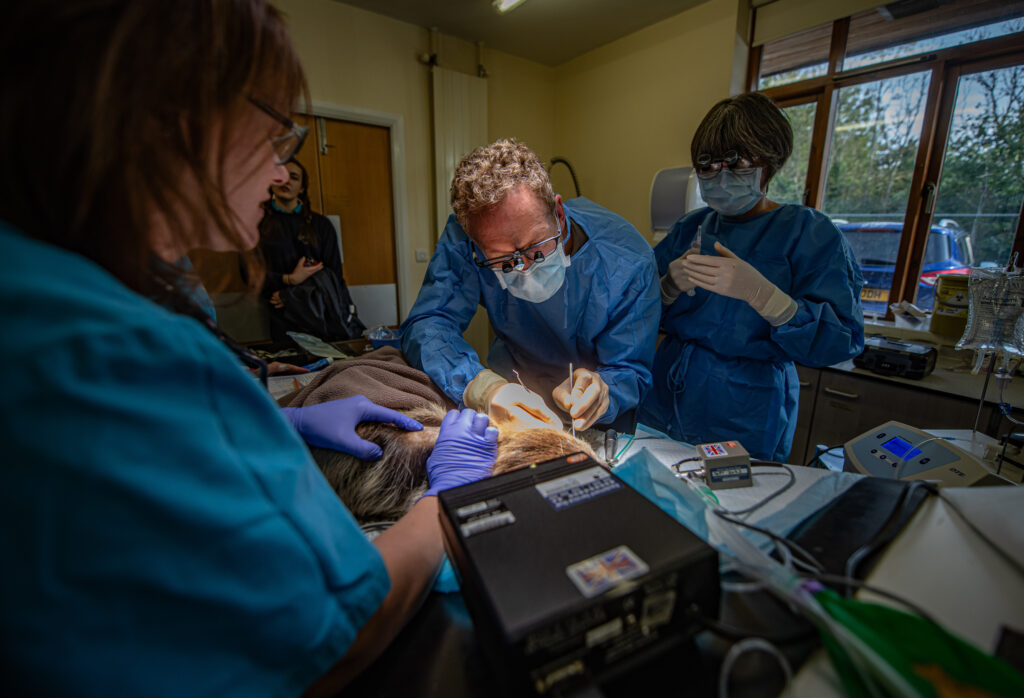Pioneering surgery by Newcastle dental experts to cure a sloth’s toothache has been a success.
Early last year, keepers at Chester Zoo first spotted that 25-year-old Rico, a two-toed sloth, had swellings on the side of his face.
A series of health check-ups, including a CT scan, revealed that Rico had two root abscesses and experts from Newcastle were called in to perform an endodontic procedure.
The three-hour surgery was done inside the zoo’s on-site animal care centre where the specialist team removed infected tissue surrounding two of the sloth’s teeth.
The team managed to save one tooth and stop both infections spreading. Dental issues can recur, so Rico has been regularly monitored since the surgery and is doing well.
“Very rewarding experience”
Dave Edwards, clinical fellow at Newcastle University’s School of Dental Sciences and honorary speciality trainee in endodontics at Newcastle’s Dental Hospital, said: “A three-dimensional scan showed that routine root canal treatment would not be possible.
“So, we undertook surgery to remove the abscess and complete an ‘apicectomy’. This involved removing the end of the tooth root and sealing it with a special cement.
“Both abscesses cleared up within a week, and it’s great that Rico remains free of infection. It was very challenging working on a sloth due to their unique anatomy, but also a very rewarding experience.”
Unlike a typical root canal, the dental experts went in through the bottom of Rico’s tooth, through the side of his lower jawbone.

Challenging dentistry
Charlotte Bentley, veterinary resident at Chester Zoo, said: “Sloths have very different teeth to humans, which makes dentistry challenging. The large sharp teeth that were affected in Rico were caniniform teeth which are highly specialised molars.
“Due to the tooth’s sharp point, and the fact there was a large amount of infection present at the base of the tooth, we needed to look for alternatives to a standard root canal to have any chance of saving the teeth.
“Like so many things with sloths, the exact purpose of these specialised sharp teeth is not fully understood. However, they are thought to serve an important role in biting and shearing their food, so we were eager to try to avoid any extractions during the initial operation.
“Whilst we couldn’t save both teeth, the great news is that since his procedure, the abscesses have not come back, and his latest X-ray shows his filling is still in place.
“It’s safe to say that the treatment worked at treating his tooth infections.”
Persuading a sloth to position himself for an X-ray is a process in itself. Where possible, the team tries to use training, so animals don’t have to undergo repeat anaesthetics for routine procedures.
Two-toed sloths are found across South America where they face a wide variety of threats such as habitat loss, logging and hunting for the illegal wildlife trade. At Chester Zoo, the species is part of an important conservation breeding programme.
Going at sloth speed
Rico has been trained to climb down towards his keepers when they call his name in a low voice. Brittany Williams, a keeper on the Twilight team at Chester Zoo, has patiently worked with him over several years to acclimatise him to being checked for lumps and bumps and to keep his mouth open so his teeth can be inspected.
“He goes at his own pace,” Brittany laughed, when Rico spent a few minutes yawning and blinking before heading to his health check. “But I don’t mind working at sloth speed.”
As part of the recall training, Rico has learned that if he touches his nose to the end of a target stick, he receives a reward. Brittany moves the target stick away and he follows, hoping for another snack. This way, she can persuade him to move from branch to branch without touching him.
This gentle method of moving Rico into the right place reduces any potential stress when carrying out health checks and procedures like the recent X-ray.
His keepers have rigged up a branch that he can hold onto when he’s being weighed, too, which makes his twice-monthly weigh-ins much easier.
Brittany said: “We are really lucky with Rico. I started working with him two or three years ago to get him used to conscious claw-checking, as they grow continuously and need trimming every three to four months.
“Rico is very food motivated, so once I found out his favourite snacks, cooked parsnips and corn kernels, it was just a case of being consistent.
“As soon as he learns a behaviour, that’s it. It’s like riding a bike. He won’t forget it. He’s great at recall.
“He’s come down every day for a year when we’ve called for him, and he generally responds on the first attempt from anywhere in his enclosure. He even recalls into his nest box.
“He’s still learning to keep his mouth open for a little longer for dental checks, but he’s getting there.”
They might look cute, slow and fluffy, but working with sloths is not something the keepers treat lightly. Their strong teeth and long, curved claws mean they are capable of biting and swiping.
“You’re working with them without a barrier. There’s nothing between you and their claws. But Rico has never swiped me,” said Brittany. “He’s a very good boy. He trusts me and I have a lot of faith in him.”

Once-in-a-lifetime opportunity
Fiona Beddis, dentist at Newcastle Dental Hospital and associate clinical lecturer at the Newcastle University department of restorative dentistry, said it was a once-in-a-lifetime opportunity to treat Rico.
She said: “It’s a great privilege to treat such a rare and beautiful animal. I felt great empathy with Rico as I underwent the same procedure on my front tooth when I was 16 years old and this in fact inspired me to become a dentist. Rico experienced much less post-operative swelling than I did.
“One of my favourite memories is receiving a message from ‘Rico’ one week after surgery saying ‘Good morning, Fiona and Dave. I’ve been very well behaved and eaten all my vegetables overnight.
“I’m less interested in the pellet but that is pretty normal for me. My face isn’t very swollen and I’m very bright. I’ve taken my pain meds well this morning and everyone is very happy with me.’
“Having never carried out this procedure on a sloth, it really was a step into the unknown, so we are all delighted with the successful surgical outcome.”
